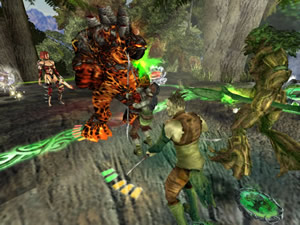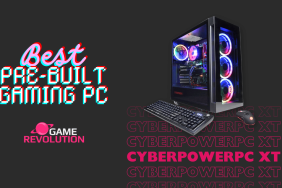Whoever spelt it, dealt it.
Every time one of these new Magic: The Gathering games shows up, it gets assigned
to me and I’m forced to once again admit publicly that I have a whole drawer filled
with old Magic cards. Most of my friends stopped playing a long time ago and I
probably haven’t played myself in over a year. I should really just get my act
together and
sell my cards on ebay. I could probably take a trip to Spain with the proceeds.
But instead, I have a drawer full of dusty cards, no tickets to Europe, and bullfighting is still illegal in California.
Magic
fans should know that unlike MTG
Online, Battlegrounds is only loosely based on the card
game. There are no cards, no lands, no phases or rounds. It’s a unique mix of
action and strategy, which gets big points in my book for originality.
Battlegrounds, like its cardboard inspiration, is a dueling
game. As a wizard, you must challenge other wizards and try to take them down,
one on one. You fight in an arena, which is a big rectangle with a border down
the middle like a tennis court. You can cross to your opponent’s side, but only
briefly before you start taking damage. For most of the battle, you run around
your side, collecting mana crystals, summoning creatures to attack the enemy
wizard, and casting various other support spells. The winner is the last one
standing.
There are five schools of magic represented by five colors: red, green, blue,
black and white. Each color has its strengths and weaknesses, and you can only
choose ten spells when you put together your spellbook. You need to use mana
to cast any spell, so collecting the little mana crystals is very important,
and unlike the card game, mana is colorless and works for any spell school.
Just to add a little more combat flair, your wizard also has a weak, short-ranged
physical attack which is useful for dealing with puny enemy creatures or those
that are almost dead, and a mana-consuming shield that absorbs half the damage
of any hit you take.
In a sense, Battlegrounds plays like a fighting game. Instead
of throwing punches, you throw spells. In fact, the menu and the modes work
just like a fighting game. There’s Quest mode, Arcade mode, VS mode, and Duel
Online.
Although there is some kind of plot about the fate of the world, the Quest mode should really be called Training. You simply take on one challenger after another in duels that often have a strange rule twist. After each one, you gain a new spell which you must use at least once in the next duel to win. In this way, the game forces you to learn all five colors of magic.
Arcade mode is exactly what you’d expect from a fighting game: beat a series
of challengers in order to unlock new fighters. VS mode puts you up against
your friend on the couch – just choose your fighter, er, wizard, and punish
him for drinking your last beer.
Finally, once you’ve unlocked plenty of spells and characters, it’s time to
go online and get humiliated by a nine year-old. Matchmaking is easy and painless,
although you’re likely to lose at first unless you have a lot of practice under
your belt. Downloadable content in the form of new spells and whatnot will become
available as time goes on.
 Which
Which
would be welcome, especially some new spells. Each color has only 14 spells,
which feels pretty slim when you compare it to the tens of thousands of spells
in the card game or the hundreds of moves in most fighting games.
The graphics are pretty good with nice textures and vibrant colors. The various
backgrounds outside your tennis court are just eye candy and have no effect
on what goes on inside the arena. The impressive spell effects are the best
part, but the players and their creatures don’t look bad, either. Shadows, however,
are the prehistoric gray disks under everyone’s feet. That’s just lazy, if you
ask me; the technology went way beyond that years ago.
The Xbox and PC versions look about the same. The camera stays pretty far back so that you can see a lot of the arena, which means you miss out on a lot of the details. This isn’t so bad on the PC since your hi-res monitor still shows the little stuff, but the Xbox is hindered slightly by the fuzzy resolution of the TV.
The sound will have you tearing out your hair after a very short period of
time, though. The music is standard fantasy drek and the spells sizzle nicely,
but the duelists call out every single spell as they cast them: “Defiant Elf!
Defiant Elf! Giant Growth! Elvish Warrior! Giant Growth!” It’s like living with
the
Lightning Bolt Guy.
You can turn off the voices, which saves your sanity, but it turns out that it’s damn handy to know what your opponent is casting. Now what do you do?
The controls are a bit awkward on both the PC and the Xbox. Moving around on the Xbox is easier with the stick rather than the PC keyboard, but spellcasting could be improved on either one. You select spells to cast by pressing a series of buttons, but it becomes a chore to scroll through them if you have more that three spells of any one type (creatures, sorceries, or enchantments). This applies even to the PC keyboard, which is just silly. Battlegrounds is a fast game and fumbling through your spellbook looking for the right spell will get you killed.
But I’ve played so many Warcraft
III clones recently that it’s really refreshing to cover a game that’s actually
doing something innovative. However, it’s the online and VS games that really
flesh out Battlegrounds, since the single-player experience
is pretty flat. Some more depth in the form of more spells and a more interesting
Quest would have really helped. Still, this wizard throws a pretty good fireball.

-
Original and innovative
-
Design your own spellbook
-
Online combat
-
Boring single-player
-
Awkward control
-
Lightning bolt! Lightning bolt!







